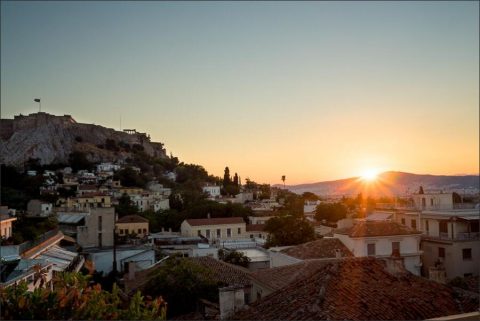Attica was a very small country according to modern notions, and Athens the only large city therein. The land barely covered some 700 square miles, with 40 square miles more, if one includes the dependent island of Salamis. It was thus far smaller than the smallest of our American “states” (Rhode Island = 1250 square miles), and was not so large as many American counties.
It was really a triangle of rocky, hill- scarred land thrust out into the Ægean Sea, as if it were a sort of continuation of the more level district of Bœotia. Yet small as it was, the hills inclosing it to the west, the seas pressing it from the northeast and south, gave it a unity and isolation all its own. Attica was not an island; but it could be invaded only by sea, or by forcing the resistance which could be offered at the steep mountain passes towards Bœotia or Megara. Attica was thus distinctly separated from the rest of Greece.
Yet Attica had advantages which more than counterbalanced this grudging of fertility. All Greece, to be sure, was favored by the natural beauty of its atmosphere, seas, and mountains, but Attica was perhaps the most favored portion of all. Around her coasts, rocky often and broken by pebbly beaches and little craggy peninsulas, surged the deep blue Aegean, the most glorious expanse of ocean in the world. Far away spread the azure water, — often foam-crested and sometimes alive with the dolphins leaping at their play, — reaching towards a shimmering sky line where rose “the isles of Greece,” masses of green foliage, or else of tawny rock, scattered afar, to adapt the words of Homer, “like shields laid on the face of the glancing deep.”
Above the sea spread the noble arch of the heavens, — the atmosphere often dazzlingly bright, and carrying its glamour and sparkle almost into the hearts of men. The Athenians were proud of the air about their land.The third great element, besides the sea and the atmosphere of Athens, was the mountains. One after another the bold hills reared themselves, cutting short all the plainlands and making the farmsteads often a matter of slopes and terraces. Against the radiant heavens these mountains stood out boldly, clearly; revealing all the little gashes and seams left from that long-forgotten day when they were flung forth from the bowels of the earth. None of these mountains was very high: Hymettus, the greatest, was only about 3500 feet; but rising as they often did from a close proximity to the sea, and not from a dwarfing table-land, even the lower hills uplifted themselves with proud majesty.
These hills were of innumerable tints according to their rocks, the hue of the neighboring sea, and the hour of the day. In spring they would be clothed in verdant green, which would vanish before the summer heats, leaving them rosy brown or gray. But whatever the fundamental tone, it was always brilliant; for the Athenians lived in a land where blue sky, blue sea, and the massive rock blent together into such a galaxy of shifting color, that, in comparison, the lighting of almost any northern or western landscape would seem feeble and tame. The Athenians absorbed natural beauty with their native air.
Behind each of these mountain masses is another piece of Attica not visible from Athens. Between Hymettus and the eastward sea lies the Mesogaia Plain. It is larger and more fertile than the plain of the Cephissus, and yet figures little in history, for no highroad passes through it. Attica’s back-parlour, should one say? Behind Pentelicus lies the plain of Aphidnae, lying saucer-like with a ring of hills around it and a piece of rising ground in its centre. The great plain behind Parnes does not belong to Attica but to Bœotia. Parnes is the one landward boundary of the Attic peninsula. Towards the west her soaring ridges dip to Mount Aegaleus, and behind these is the sea-girt Thriasian plain around Eleusis, now reckoned as Attic territory.
The Athenian loved sunshine, and Helios the Sun God was gracious to his prayers. In the Athens of to-day it is reckoned that the year averages 179 days in which the sun is not concealed by clouds one instant; and 157 days more when the sun is not hidden more than half an hour. Ancient Athens was surely not more cloudy. Nevertheless, despite this constant sunshine and a southern latitude, Athens was striken relatively seldom with semitropical heat. The sea was a good friend, bringing tempering breezes. In the short winter there might be a little frost, a little snow, and a fair supply of rain. For the rest of the year, one golden day was wont to succeed another, with the sun and the sea breeze in ever friendly rivalry.
The climate saved the Athenians from being obliged to wage a stern warfare with nature as did the northern peoples. Their life and civilization could be one developed essentially “in the open air”; while, on the other hand, the bracing sea breeze saved them from that enervating lethargy which has ruined so many southern folk. The scanty soil forced them to struggle hard to win a living; unless they yielded to the constant beckoning of the ocean, and sought food, adventure, wealth, and a great empire across the seas.
Visits: 176



